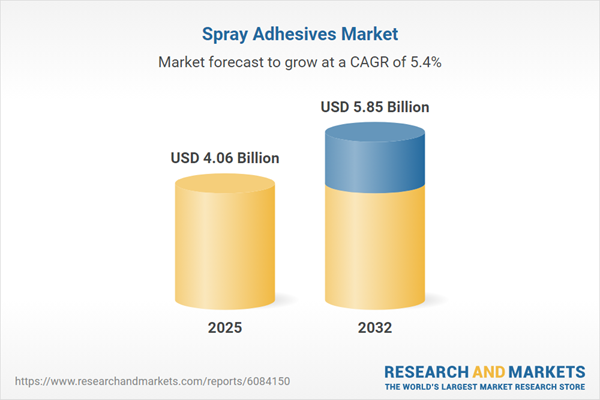Speak directly to the analyst to clarify any post sales queries you may have.
The spray adhesives market is undergoing significant transformation, driven by changing industry requirements, rapid innovation, and evolving global regulations. For senior decision-makers, understanding this landscape is essential to capitalize on emerging prospects and mitigate operational risk.
Market Snapshot: Spray Adhesives Market Growth
The Spray Adhesives Market grew from USD 3.85 billion in 2024 to USD 4.06 billion in 2025. It is expected to continue growing at a CAGR of 5.35%, reaching USD 5.85 billion by 2032.
Comprehensive Scope & Segmentation
This report delivers in-depth coverage of market drivers, granular segmentation, and regional developments. Analysis encompasses:
- Product Types: Hot melt adhesives (EVA based, polyamide based), reactive adhesives, solvent based adhesives, water based adhesives (acrylic based, latex based).
- Applications: Automotive (exterior, interior), construction (flooring, roofing), packaging (corrugated, flexible), woodworking (edge banding, panel lamination).
- End User Industries: Automotive, construction, furniture, packaging.
- Sales Channels: Direct sales, distribution (specialist distributor, wholesale distributor), e-commerce (manufacturer website, third party marketplace).
- Geographic Regions: Americas (North America, Latin America), Europe, Middle East & Africa, Asia-Pacific.
Coverage of recent advances explores shifts in chemistries, such as the rise of eco-friendly adhesives and the adoption of digital technologies for both formulation and supply chain enhancement. Regional analysis examines how economic maturity, industry focus, and regulation impact segment performance and innovation strategies.
Key Takeaways for Market Strategy
- Spray adhesive adoption is expanding across sectors including manufacturing, packaging, construction, and woodworking due to rapid bonding and compatibility with a variety of substrates.
- Eco-friendly product development is increasing, with a focus on renewable raw materials and low VOC formulations that align with regulatory and end-user expectations.
- Digitalization is streamlining both formulation and operational efficiency, enabling predictive modeling and faster market entry for innovative adhesive solutions.
- Supply chain transparency and agile logistics are vital as tariff changes and raw material availability influence procurement and cost structures.
- Strategic partnerships among adhesive producers, equipment suppliers, and end-users are fostering tailored solutions and accelerating commercialization of advanced technologies.
- Geographic nuances require region-specific innovation, particularly as Asia-Pacific and emerging EMEA markets generate new growth opportunities fueled by industrial expansion and infrastructure projects.
Tariff Impact: 2025 United States Adjustments
Forthcoming changes to United States tariff structures will influence input costs, especially through elevated pricing on imported polymers and solvents. Manufacturers are responding by exploring nearshoring strategies to boost local sourcing and resilience. Downstream industries are evaluating alternative adhesives and considering longer-term contracts to manage budget predictability. Flexible supply chain approaches and scenario-based planning can help mitigate margin pressures and support continuity amid fluctuating regulatory landscapes.
Methodology & Data Sources
This analysis utilizes a hybrid methodology combining primary expert interviews with formulation scientists and executives, alongside a comprehensive review of technical literature, regulatory filings, and supplier white papers. Cross-verification and iterative consultation ensure objective, reliable findings.
Why This Report Matters
- Identify actionable opportunities for innovation, differentiation, and sustainable growth in a complex market landscape.
- Gain clarity on how regulatory shifts, supply chain dynamics, and emerging technologies affect strategic investments and sourcing decisions.
- Use robust segmentation and regional intelligence to craft market entry and expansion strategies tailored to specific sectors and geographies.
Conclusion
The spray adhesives market is shaped by technological progress, sustainability imperatives, and shifting geopolitical factors. Senior leaders equipped with this insight can adapt business models and strengthen their market positions for long-term success.
Table of Contents
3. Executive Summary
4. Market Overview
7. Cumulative Impact of Artificial Intelligence 2025
Companies Mentioned
The companies profiled in this Spray Adhesives market report include:- 3M Company
- Henkel AG & Co. KGaA
- Bostik SA
- H.B. Fuller Company
- RPM International Inc.
- Avery Dennison Corporation
- Illinois Tool Works Inc.
- Ashland Global Holdings Inc.
- Sika AG
- Franklin International, Inc.
Table Information
| Report Attribute | Details |
|---|---|
| No. of Pages | 184 |
| Published | November 2025 |
| Forecast Period | 2025 - 2032 |
| Estimated Market Value ( USD | $ 4.06 Billion |
| Forecasted Market Value ( USD | $ 5.85 Billion |
| Compound Annual Growth Rate | 5.3% |
| Regions Covered | Global |
| No. of Companies Mentioned | 11 |









